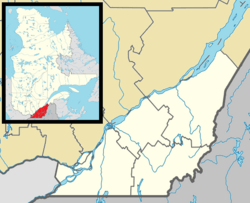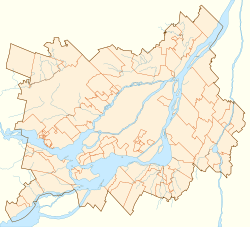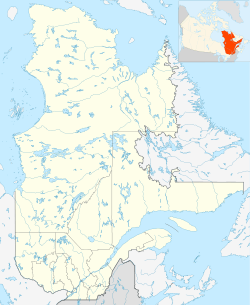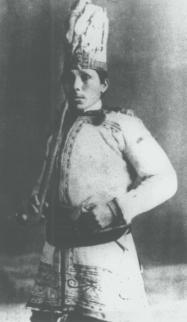Kanesatake facts for kids
Quick facts for kids
Kanehsatà:ke
|
|
|---|---|
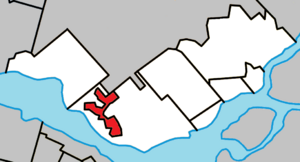
Location within Deux-Montagnes RCM.
|
|
| Country | |
| Province | |
| Region | Laurentides |
| RCM | Deux-Montagnes |
| Area | |
| • Land | 11.88 km2 (4.59 sq mi) |
| Population
(2022)
|
|
| • Total | 1,364 |
| Time zone | UTC−5 (EST) |
| • Summer (DST) | UTC−4 (EDT) |
Kanesatake (Kanehsatà:ke in Mohawk) is a special Mohawk community. It is located on the shore of the Lake of Two Mountains in southwestern Quebec, Canada. This area is where the Ottawa and Saint Lawrence rivers meet. It is about 48 kilometers (30 miles) west of Montreal.
People who live in Kanehsatà:ke are called Mohawks of Kanesatake. In 2022, about 1,364 people lived there. The Mohawks of Kanesatake and the Mohawks of Kahnawake also have hunting and fishing rights in the Doncaster 17 Indian Reserve.
The Mohawk people were historically the easternmost nation of the Haudenosaunee (Six Nations Iroquois). By 1730, this group included six Iroquoian-speaking nations. They lived mostly in what is now New York and Pennsylvania. They also controlled hunting lands that reached into the Ohio and Shenandoah valleys.
After French explorers arrived, traders worked with the Mohawk. Jesuit missionaries also came to teach their people. Some Mohawks moved closer to French settlements in Quebec for trade. In the mid-1800s, the British government recognized the people of Kanehsatà:ke as one of the Seven Nations of Canada. These were First Nations who were allies of the British.
Today, Kanesatake is a self-governing Mohawk community in Canada. The Canadian government calls it an "interim land base." Other Mohawk communities, like Kahnawake and Akwesasne, are called "reserves" under the Indian Act.
Contents
A Look Back: Kanesatake's History
By the 1300s, some Iroquoian-speaking peoples lived in villages along the St. Lawrence River. These people are now called the St. Lawrence Iroquoians. French explorer Jacques Cartier visited their villages, like Stadacona and Hochelaga, in 1535–1536.
About 75 years later, when Samuel de Champlain explored the same area, these villages were gone. The Kanienkehaka (Mohawk) people, from other Iroquoian lands, used the valley for hunting. Historians believe the stronger Mohawk may have fought the St. Lawrence Iroquoians. They wanted to control the fur trade and hunting in the valley.
By 1600, the Mohawk of the Iroquois Confederacy used the St. Lawrence Valley for hunting. The Mohawk were the easternmost of the Five Nations. Even though the Mohawk shared some culture with earlier Iroquoian groups, studies show they were different peoples. Historians believe the Mohawk pushed out the St. Lawrence Iroquoians.
During the colonial period, the French set up trading posts and missions with the Mohawk. There were also times of conflict between them. Some Mohawks moved near Montreal for trade and safety at mission villages.
The Land Grant and Sulpician Order
In 1717, the King of France gave the Mohawk in Quebec a large piece of land. It was about 9 miles long and 9 miles wide, northwest of Montreal. The condition was that they leave the island of Montreal. The Kanesatake settlement officially started as a Catholic mission. It was overseen by the Sulpician Order for about 300 Christian Mohawk, 100 Algonquin, and 250 Nipissing peoples.
Over time, the Sulpicians claimed full control of the land. They got a legal document that gave them ownership. But the Mohawk believed this land was being held in trust for them. This means they thought the Sulpicians were just looking after the land for the Mohawk people.
The Sulpician mission village became known by its Algonquin name Oka (meaning "pickerel"). It was also called Kanehsatà:ke in Mohawk ("sandy place"). The Algonquin also called the village Ganashtaageng after the Mohawk name.
Many Mohawks in Quebec became Catholic during this time. But they grew unhappy with the Sulpicians. They felt they were treated unfairly about their land rights. The Sulpicians sold some of the land for new settlements. This is how the village of Oka grew up around the Kanesatake community. In 1787, Chief Aughneeta wrote to Sir John Johnson. He complained that the Mohawk had moved to Kanesatake only because the King of France promised them a deed to the land.
By 1851, the Mohawk had protested the land issue to the government seven more times. Their unhappiness grew. In 1868, the Mohawk chose Sosé Onasakenrat as chief. He was only 22 years old. He had been educated by the Sulpicians and worked with them. That year, he went to Montreal to present the Mohawk land claim. But it did not work. Later that year, he and many other Mohawks became Protestant. They were upset by how the Catholic Church treated them.
In 1880, Onasakenrat became a Methodist missionary. He worked in Mohawk communities like Kahnawake and Akwesasne. He began to suggest that the Mohawks accept an offer from the Sulpicians. The Sulpicians offered to buy land for the Mohawk away from Oka and pay for their move. He lost the support of many people because of this change. He died in 1881 at age 35. Six months later, only 20 percent of the Mohawk left Kanehsatà:ke. They moved to present-day Wahta Mohawk Territory near Muskoka, Ontario.
In 1910, the Canadian Supreme Court said the Sulpician Order's claim to the land was valid. Kanesatake is still called an "interim land base" by the federal government. This is different from "reserves," which are created under the Indian Act.
Understanding the Oka Crisis
Kanehsatà:ke is the oldest continuous Mohawk community. It existed even before Europeans arrived. The town of Oka grew up around the Lake of Two Mountains. This happened because the Sulpician order sold land that belonged to the Mohawk community of Kanehsatà:ke. The Sulpicians sold land to French settlers and became the biggest landowners in the region.
Since 1717, the Mohawk have argued against the Sulpician land claim. They say that the King of France, Louis XIV, never owned the land. So, the Crown did not have the right to give the land to the Sulpician Order.
This territory includes a pine forest and a cemetery that the Mohawk have used for a long time. It is still accessible, even though it is not part of the Kanesatake reserve. The Mohawks of Kanesatake have tried many times to solve this land dispute. But their claims were rejected by the government.
Events of 1990
In 1990, the town of Oka decided to expand its 9-hole golf course to an 18-hole course. They also planned new buildings. The Mohawk formally protested. This development would affect their historic cemetery, which they considered sacred. The city continued with the plans despite the protests.
In response, the Mohawk put up a barricade on a dirt road leading to the pine forest. They wanted to stop developers from cutting trees. The city got three court orders against the barricade. The Mohawk tried to get a pause on the development. But on July 11, 1990, the provincial police, Sûreté du Québec (SQ), raided the barricade.
Oka asked the SQ for help. The SQ then blocked Route 344 leading to Kanehsatà:ke. In the first days of the conflict, a police officer was killed in a gunfire exchange with protesters. The SQ were joined by Canadian army and Montreal police. The Quebec government asked the Canadian Army for support, and 3700 troops were sent in. This started a 78-day standoff between the Mohawk Nation and their allies against the police and Canadian Army.
The nearby Mohawk community of Kahnawake put up a barricade on the Mercier Bridge. This was to protect the people of Kanehsatà:ke from another raid. People who were not Mohawk became angry about traffic delays.
Leaders from the province and the country tried to negotiate. But the land issue was not solved. The International Federation of Human Rights, based in Paris, France, investigated. They said that neither the provincial nor federal governments acted fairly during talks.
The Canadian Army forced the Mohawk at Kanehsatà:ke to remove their barricades. Police and military forces pushed the remaining protesters back. They were confined to the Onentokon Treatment Centre and surrounded by the military.
In the end, the Mohawk chose to leave the treatment center. They did not formally surrender. Those who stayed at the center were arrested. Men and women were separated and sent to an army base. Other Mohawk activists were arrested for actions before the army arrived. As of 2019, the land dispute is still ongoing.
Representation in Other Media
- Some of the events and history are shown in Alanis Obomsawin's documentary film, Kanehsatake: 270 Years of Resistance (1993).
- Beans is a fictional film by Tracey Deer. It was shown at the 2021 New York International Children's Film Festival. The film is set during the Oka crisis. It stars Kiawenti'io Tarbell, a young Mohawk actress from Akwesasne.
How Kanesatake is Governed
The Mohawk at Kanehsatà:ke used to follow "custom." This meant clan mothers would choose chiefs from clans with traditional leadership roles. Clan mothers could also remove a chief if they were unhappy with his actions. Like other Iroquois nations, the Mohawk had a matrilineal kinship system. This means inheritance and property were passed down through the mother's side of the family.
In the late 1900s, the Mohawk tried to get their land back at Kanesatake. But the courts ruled against them. The community is surrounded by the city of Oka, Quebec.
In 2001, the government passed a law (S-24). This law was meant to make the relationship between Kanesatake and the federal government similar to that of reserves. However, people in the community have different ideas about what this law means. These disagreements have caused tension among different groups in the community.
Changes After the Oka Crisis
After the Oka Crisis, the Mohawk of Kanehsatà:ke changed how they govern themselves. In 1991, citizens held their first general elections for a grand chief and six council chiefs. Before this, chiefs had traditional claims to their positions through their clans.
Jerry Peltier was elected as grand chief in 1991 and served until 1996. He also led the Quebec First Nations Education Council.
In the 1990s, the community started to have more control over its own affairs. They even set up their own police force.
In 2004 and 2005, there were disagreements about how Grand Chief James Gabriel was governing. He had been elected three times. These disputes led to problems in Kanehsatà:ke. Chiefs Pearl Bonspille, Steven Bonspille, and John Harding opposed Gabriel. They and others ended Gabriel's time as grand chief.
John Harding and council chiefs Steven Bonspille and Pearl Bonspille said they disagreed with Gabriel's attempts to control policing. Gabriel's home was burned in an incident, and he left the community for Montreal.
The community then created a Community Watch team because there was no police force. They also worked with the SQ. Communication lines were opened with the Quebec government to prevent another crisis like the one in 1990.
After Gabriel's removal, elections were held on June 26, 2005. Steven Bonspille won against Gabriel for grand chief. Harding and Pearl Bonspille were replaced as chiefs. The community was managed by a federal trusteeship while an investigation into spending was done.
People in the community continue to be very involved in politics. In 2008, about 25 candidates ran for seven council seats. More than 2300 Kanesatake voters were registered.
As of 2015, the grand chief of Kanesatake was Serge Otsi Simon. After he was elected, he spoke about the Oka Crisis in an interview with the Montreal Gazette.
The community also has a traditional form of governance under the longhouse system. This system existed before contact with Europeans. Many in the community still follow it. However, Canada does not officially recognize the longhouse leaders in decisions about land rights.
Community Initiatives
In 2013, the Kanehsatà:ke Health Centre Inc. was the first Indigenous health center in North America to receive a Baby Friendly Accreditation. This means it supports breastfeeding and mother-baby bonding.
That same year, a local group called Pikwadin started to improve the local radio station, CKHQ 101.7 FM. The station had been quiet since its manager died in 2003. In 2004, the station did not renew its broadcasting license. It operated as a pirate radio until its license was accepted on June 17, 2014. A non-profit group from Montreal, Exeko, helped with the licensing process.
Education for Kanesatake Students
Students in Kanesatake can attend schools through different school boards.
The French school board is Commission scolaire de la Seigneurie-des-Mille-Îles. The schools for this area are:
- École des Pins (Oka)
- École secondaire d'Oka (Oka)
The English school board for the area is the Sir Wilfrid Laurier School Board. In 2014, 55 students from Kanesatake chose to attend Lake of Two Mountains High School in Deux-Montagnes. Kanesatake is within the attendance area for this school. Mountainview Elementary School and Saint Jude Elementary School, both in Deux-Montagnes, also serve this community.
See also
 In Spanish: Kanesatake para niños
In Spanish: Kanesatake para niños
- Mohawks of Kanesatake
- Kanehsatake: 270 Years of Resistance, 1993 documentary by Alanis Obomsawin
- Joseph Onasakenrat, Chief of the Mohawk nation at Kanesatake, 1868–1881


